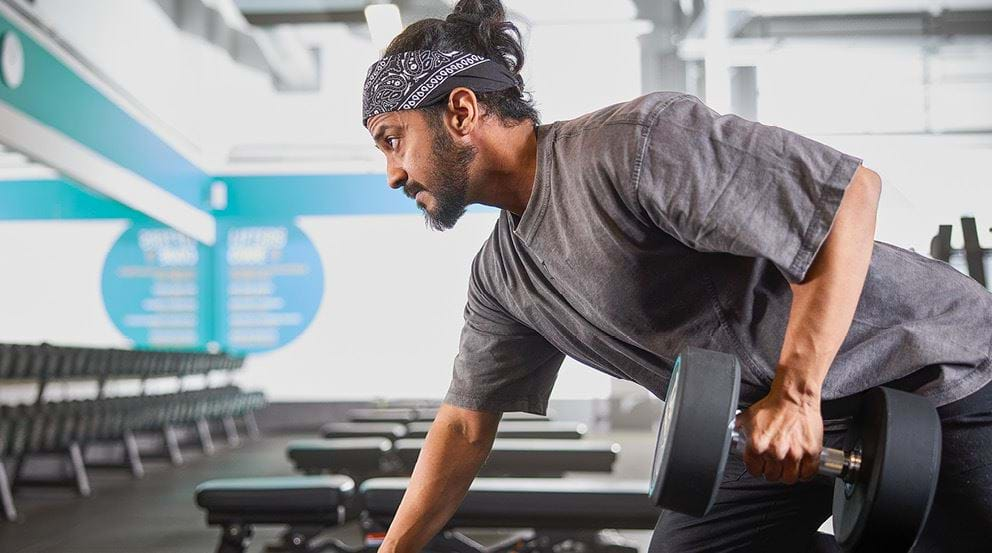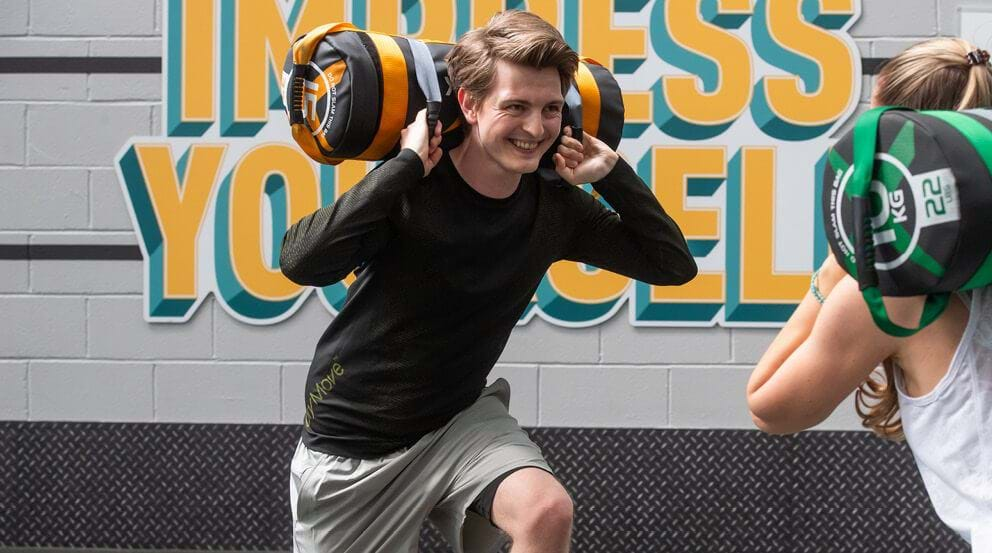How To Recover From An Injury Faster Using The Gym

Working Through An Injury | How To Recover Faster | Mental Recovery | Recovery At The Gym | ACL Injuries | Achilles Injuries | Shoulder Injuries | Knee Injuries | Rotator Cuff Injuries | How Athletes Recover
Page last updated: 16th May 2024
Injuries, unfortunately, are an all too common part of life. Whether it's a knee injury from running, a shoulder injury at the gym or something as simple as jarring your neck after sleeping awkwardly, injuries happen and they can be frustrating. This is especially true when they take us out of the gym for weeks or months.
Taking long breaks from any exercise routine naturally leads to a drop in strength, endurance and overall physical fitness. Fortunately, an injury doesn't always mean you need to stop working out completely. In fact, exercising in the right way can help you to recover from many injuries.
In this guide, we'll show some ways the gym can help you to recover from an injury.
The Basics Of Working Through An Injury
Exercise can be a useful tool in dealing with an injury, but it's important to avoid rushing back into your regular fitness routine too early as this can delay healing or further aggravate the injury.
Historically, advice for an injury has been to rest and ice it completely until healed but this is now thought of as outdated. Rehabilitation advice now focuses on protecting the injury in the first few days and then gradually returning to normal activity by incrementally increasing load to build strength and mobility in the affected area. This often involves injury specific rehabilitation exercises before diving back into your normal workout schedule.
There are a few things to remember before starting back at the gym:
- **Avoid movements that increase pain in the first few days. **The first few days after an injury are when you will experience most pain and swelling. Gentle movement can help to get blood flow to the area which is helpful for healing, but avoid any activities that increase pain. Elevation and compression can be helpful tools, but ice and anti-inflammatory medication can delay healing so are best avoided if possible.
- **Listen to your body. **As you introduce movement back into your routine, listen to your body and use this as a guide to whether you should increase or decrease the activity. Some discomfort is normal but a large increase in pain is a sign you are pushing too far, too fast.
- **Follow your doctor's advice. **If you've seen a healthcare professional for your injury, follow their recommendations as these will be bespoke to your needs. Whether it's rest, physical therapy, or specific exercises, trust their expertise and stick to the plan.
- **Gradually increase level of intensity. **While you are recovering from an injury, and even after, your body can handle less than its used to. To avoid re-injuring yourself, start at a low level of intensity and impact and gradually increase this over time. If you have any pain or symptoms flare up, dial it back and take it even slower. Avoid high-intensity workouts or heavy lifting until you've fully regained your strength and flexibility. Gradually increase the intensity and duration of your workouts as your body allows.
- **Address the cause of injury. **Often, injuries can be down to not having enough strength or mobility for the level of activity you were doing. Identify what may have contributed to your injury and work on this area, making sure to improve this gradually over time.
3 Steps To Help You Recover From An Injury Faster
Everyone's body and injuries are unique, and there is no 'one way' to fast track yourself to recovery. However, the quicker you're able to be seen by a medical professional to assess your injury, the faster you'll be able to be put onto a recovery plan.
Once you've been cleared to move on from specific rehab exercises and resume different styles of workouts, you'll still want to take some precautions to ensure you remain injury free as you build up your activity levels. Working with a personal trainer is a great way to help you safely ease back into your fitness routine post-injury, but if this isn't the right route for you here are some basic steps to keep in mind:
Increase pain free range of motion
Start your gym sessions with gentle stretching and mobility exercises to help improve your flexibility and range of motion, as this can decrease the likelihood of an injury occurring in future. Incorporating resistance bands into this is a great way to add resistance and support to your mobility and flexibility exercises, building strength in your new ranges.
Try low impact cardio
Instead of jumping straight into high-intensity cardio workouts, opt for low-impact exercises like walking, cycling, swimming, or using the elliptical machine. Cardio exercise is great for overall fitness but also improves blood flow to injured areas, which can further help with healing, and a low impact option allows you to get these benefits without putting excessive strain on your recovering injury.
Begin with bodyweight
As you move back to strength exercises, start with bodyweight versions to ease back into the movements. If you can do this with no pain, you can begin to slowly add weights. Avoid jumping back to the same weights and intensity as before your injury to avoid any issues.
How To Mentally Recover From An Injury
Dealing with the mental side of an injury can be just as challenging as the physical for some people, but being optimistic and staying positive can help with recovery.
Here are some tips to help deal with the mental challenge of recovering from an injury.
Set some goals
Take this downtime as a chance to rethink your fitness game plan and set some new goals for when you're back in action. Maybe you want to improve your flexibility, work on your endurance, or even try out a new sport. Having something to aim for can give you a sense of purpose and motivation to keep pushing forward.
Accept your situation
We know it's a tough pill to swallow, but it's important to accept where you're at and focus on what you can do to get better. Instead of dwelling on what you can't do, try to focus on the things you can control, like sticking to your rehab exercises or finding alternative ways to stay active that won't aggravate your injury.
Speak to a physiotherapist or personal trainer
Both can give you tips and exercises to help you recover faster and get back to doing what you love. Plus, chatting with someone who understands can be a big help mentally, too. Remember, you're not alone in this, and there are people out there who want to help you get back on track.
How The Gym Can Help With Your Injury
The gym can be a great place to work on your rehab and recovery plans. That said, the below exercises and recovery plans are only basic recommendations and may not be suitable for all people and injuries.
We strongly advise seeking guidance from a qualified physiotherapist or physical therapist to develop a more specific and tailored recovery plan based on your individual needs, injury severity, and stage of rehabilitation.
ACL (Anterior Cruciate Ligament) Injuries
Estimated recovery time: Anywhere between 6-12 months.
Common causes: Sudden stops, changes in direction, pivoting, or landing awkwardly from a jump.
Recovery plan: Initially, focus on rest, ice, compression and elevation (RICE) to reduce inflammation. Followed by physical therapy to regain range of motion, strengthen surrounding muscles (quadriceps, hamstrings, calves), and improve stability. Gradual reintroduction of weight-bearing activities and sports-specific exercises under guidance.
ACL Injury Recovery Exercises
Phase 1 (Early Recovery):
- Stationary bike: 10-15 minutes for warm-up, low resistance
- Leg press: 2 sets of 10-12 reps, light to moderate weight
- Hamstring curls: 2 sets of 10-12 reps, light to moderate weight
- Seated calf raises: 2 sets of 10-12 reps
- Wall sits: 2 sets of 20-30 seconds
- Cool down with stretching: Quadriceps, hamstrings, calves
Phase 2 (Mid Recovery):
- Gradual increase in resistance and duration for cardio
- Introduction of single-leg exercises: lunges, step-ups and single-leg squats
- Stability exercises: Bosu ball squat and stability ball leg curls
- Core strengthening: Planks, side plank
- Resistance band exercises: lateral walks, clamshells, monster walks
Phase 3 (Late Recovery):
- Progressive overload in strength training: Increase weight and intensity
- Plyometric exercises: Box jumps, jump squats (under supervision)
- Sport-specific drills: Agility ladder, cone drills, cutting movements
- Continued focus on stability, balance, and proprioception
Achilles Injuries
Estimated recovery time: 6-12 weeks for mild injuries, longer for more severe injuries.
Common causes: Overuse, sudden changes in intensity, inadequate warm-up.
Recovery plan: Rest, ice, compression, elevation (RICE), stretching, strengthening exercises (eccentric calf exercises), gradual return to weight-bearing activities.
Basic Gym Recovery Workout for Achilles Injuries
Warm-up:
- Multi direction ankle motions with toe taps: Imagine you're standing in the centre of a clock face. Balancing on your left leg, lift your right foot and, pointing your toe as far as you can reach, tap where each number of the clock would be (e.g. straight in front of you for 12, to your right for 3), returning to centre after each tap. Continue for around 60 seconds before repeating with the other foot.
- Calf Raises on a Flat Surface: Do 2 sets of 10-15 repetitions to gradually warm up the calf muscles and Achilles tendon
Strengthening and Rehabilitation:
- Eccentric Calf Raises: Perform 3 sets of 10 repetitions, focusing on the lowering (eccentric) phase of the movement. Stand on a step with your heels hanging off the edge, then rise up onto your toes with both feet, and slowly lower your heels below the level of the step
- Towel Scrunches: Sit on a chair with a towel placed flat on the floor in front of you. Place your foot on the towel and scrunch it towards you using your toes. Perform 3 sets of 10-15 repetitions per foot to strengthen the muscles of the foot and ankle, which support the Achilles tendon
Resistance Band Ankle Dorsiflexion:
- Sit on the floor with your legs extended in front of you. Loop a resistance band around the ball of your foot and hold the ends of the band with your hands. Flex your foot upward (dorsiflexion) against the resistance of the band. Perform 2 sets of 10-12 repetitions on each foot to strengthen the muscles around the ankle and improve ankle stability
Stretching and Mobility:
- Calf Stretch: Stand facing a wall with your hands against the wall at shoulder height. Step one foot back, keeping it straight, and bend the front knee while keeping the back heel on the ground. Hold for 15-30 seconds and switch sides. Perform 3 sets on each leg to stretch the calf muscles and Achilles tendon
- Plantar Fascia Stretch: Sit on a chair and cross one ankle over the opposite knee. Using your hand, gently pull your toes back towards your shin until you feel a stretch along the bottom of your foot. Hold for 15-30 seconds and switch sides. Perform 3 sets on each foot
Shoulder Injuries
Estimated recovery time: Varies depending on severity.
Common causes: Repetitive overhead movements, poor posture, sudden impacts.
Recovery plan: Rest, physical therapy, strengthening exercises (shoulder presses, lateral raises, rows), focus on stability and range of motion.
Gym Workout With a Shoulder Injury
Warm-up:
- Engage in 5-10 minutes of low-intensity activities like walking or slow cycling to increase blood flow and prepare the body for exercise.
Mobility and Flexibility:
- Shoulder Circles: Stand tall with arms relaxed by your sides. Slowly rotate your shoulders in a circular motion, first forward for 10 repetitions, then backward for another 10 repetitions.
- Cat-Cow Stretch: Start on your hands and knees with a neutral spine. Inhale as you arch your back, dropping your belly towards the floor (cow position). Exhale as you round your spine towards the ceiling (cat position). Repeat for 10 cycles.
- Shoulder Pendulum Swing: Stand with one hand resting on a surface for support. Let your other arm hang down. Gently swing the hanging arm forward and backward, then side to side, in a pendulum motion for 10 repetitions in each direction.
Strengthening with Resistance Bands:
- Shoulder External Rotation with Resistance Band: Secure a resistance band to a stationary object at waist height. Hold the other end with your injured arm, elbow bent at 90 degrees. Keep your elbow tucked in and rotate your forearm away from your body against the resistance of the band. Return to the starting position slowly. Perform 10-12 repetitions.
- Scapular Retraction with Resistance Band: Secure the resistance band to a fixed point at chest height. Hold the band with both hands, arms extended in front of you. Pull the band apart by squeezing your shoulder blades together, then return to the starting position. Complete 10-12 repetitions.
- Banded Clamshells: Lie on your side with knees bent, feet together. Place a resistance band just above your knees. Keeping your feet together, open your top knee as far as possible without rotating your hips. Slowly return to the starting position. Perform 10-12 repetitions on each side.
Core Stability:
- Dead Bug Exercise: Lie on your back with knees bent and arms extended towards the ceiling. Lower one leg towards the ground while simultaneously lowering the opposite arm overhead. Keep your lower back pressed into the floor. Return to the starting position and repeat on the other side. Complete 8-10 repetitions per side.
- Plank with Shoulder Taps: Begin in a plank position with hands directly under shoulders. Keeping your hips stable, tap one hand to the opposite shoulder, then return it to the floor. Repeat with the other hand. Alternate sides for 8-10 repetitions per side.
Cool Down and Stretching:
- Spend 5-10 minutes performing gentle stretching exercises for the shoulders, lower body, and core muscles to promote flexibility and relaxation. Stretch each muscle group for 15-30 seconds without bouncing, focusing on deep breathing and releasing tension.
Knee Injuries
Estimated recovery time: Varies depending on type and severity.
Common causes: Sudden twists, falls, overuse.
Recovery plan: Rest, physical therapy, strengthening exercises (quadriceps, hamstrings, glutes), low-impact activities (cycling), gradual return to weight-bearing exercises.
Gym Workout With a Knee Injury
Warm-up:
- 5-10 minutes of low-impact cardio such as walking on flat ground or using a stationary bike to increase blood flow to the muscles surrounding the knee joint
Mobility and Flexibility:
- Knee Circles: Stand or sit comfortably. Extend one leg out straight. Slowly rotate your knee in a circular motion, first clockwise for 10 repetitions, then counterclockwise for another 10 repetitions. Switch legs and repeat.
- Quadriceps Stretch: Stand tall, holding onto a stable surface if needed for balance. Bend one knee and bring your heel towards your buttocks, grasping your ankle or foot with your hand. Hold this position for 15-20 seconds while keeping your knees close together. Repeat on the other side.
- Hamstring Stretch: Sit on the floor with one leg extended straight and the other bent. Reach towards your toes on the extended leg, keeping your back straight. Hold for 15-20 seconds, feeling the stretch in the back of your thigh. Switch legs and repeat.
Strengthening with Resistance Bands:
- Straight Leg Raises with Resistance Band: Secure one end of a resistance band to a fixed object and loop the other end around your ankle. Lie on your back with the banded leg straight and the other bent. Slowly lift the banded leg towards the ceiling, then lower it back down. Perform 10-12 repetitions on each leg.
- Seated Leg Press with Light Resistance: Sit on a chair or bench with your feet flat on the floor. Place the resistance band around your feet and hold the ends in your hands. Push your feet forward against the resistance of the band, straightening your legs. Slowly return to the starting position. Complete 10-12 repetitions.
- Clamshells with Resistance Band: Lie on your side with knees bent, feet together. Place a resistance band just above your knees. Keeping your feet together, open your top knee as far as possible without rotating your hips. Slowly return to the starting position. Perform 10-12 repetitions on each side.
Low-Impact Cardio:
- Choose a low-impact cardio exercise such as using a stationary bike, elliptical machine, or swimming. Engage in 10-15 minutes of continuous activity to improve cardiovascular fitness without stressing the knees excessively.
Core and Balance Exercises:
- Pelvic Tilts: Lie on your back with knees bent and feet flat on the floor. Tighten your abdominal muscles to flatten your lower back against the floor. Hold for a few seconds, then release. Repeat 10 times.
- Single-Leg Balance: Stand on one leg while lifting the other leg slightly off the ground. Maintain your balance for 30 seconds. Switch legs and repeat.
Cool Down and Stretching:
- Spend 5-10 minutes performing gentle stretching exercises targeting the quadriceps, hamstrings, calves, and hip flexors to promote flexibility and reduce tension in the lower body
Rotator Cuff Injuries
Estimated recovery time: Varies depending on severity.
Common causes: Repetitive overhead movements, heavy lifting, sudden impacts.
Recovery plan: Rest, physical therapy, strengthening exercises (rotator cuff muscles), stretching exercises, gradual return to activities with a focus on proper shoulder alignment.
Gym Exercises For Rotator Cuff Injuries
Warm-up:
- Arm Circles: Stand with feet shoulder-width apart, arms extended outwards. Rotate arms in small circles, gradually increasing size. Do 2 sets of 10 reps in each direction
- Shoulder Rolls: Stand or sit upright, roll shoulders backward then forward. 2 sets of 10 reps each way
Strengthening and Rehabilitation:
- External Rotation with Resistance Band: Stand, elbow bent at 90 degrees, forearm parallel to floor. Hold one end of the resistance band in the hand of the affected arm, and the other end in the opposite hand. Keep elbow close, externally rotate shoulder. Do 2 sets of 10-12 reps
- Internal Rotation with Resistance Band: Attach band to fixed point at waist height. Stand sideways, affected arm closest to anchor, elbow bent at 90 degrees. Hold the band, internally rotate the shoulder. Aim for 2 sets of 10-12 reps
- Scapular Retraction: Lie face down, arms by sides, palms up. Squeeze shoulder blades together, lift arms off ground. Hold, then lower. Aim for 2 sets of 10-12 reps
Range of Motion and Flexibility:
- Pendulum Exercise: Stand or sit, unaffected arm supported. Let the affected arm hang down. Gently swing your arm in various directions. 2 sets of 10 reps each way
- Wall Walks: Stand facing wall, fingertips lightly touching. Walk fingers up, then back down. 2 sets of 10 reps
Functional Movements:
- Modified Press-ups: From elevated surface, keep body straight, lower chest towards surface, then push back up. 2 sets of 8-10 reps
- Seated Rows: Sit on a chair with feet flat, knees bent. Hold a resistance band or cable, palms facing each other. Pull towards your chest, squeezing shoulder blades. 2 sets of 10-12 reps
Low-Impact Cardio:
- Choose low-impact cardio exercises such as walking, cycling, or using an elliptical machine to maintain cardiovascular fitness without placing excessive stress on the shoulders. Aim for 20-30 minutes of continuous activity
*Please note that the above recovery plans are just basic plans to help you get started with your recovery. To help you with a speedy recovery, please speak to one of our certified personal trainers or rehab professionals for a specific recovery plan.
How Do Athletes Recover So Quickly From an Injury?
There are a number of reasons professional athletes, like footballers, rugby players and tennis players are able to speed up their recovery processes. Namely, they have access to some of the best healthcare professionals who provide instant and super specific recovery plans based on their needs.
Most people, when they get injured, won't have an experienced medical professional immediately at their side to assess the nature of the injury and create a plan. It can take days to get a proper assessment, and by that point the swelling may have increased and the injury could have worsened.
Plus, professional athletes will dedicate most of their days to recovery, and they'll benefit from specialised rehabilitation equipment that isn't easily accessible in standard gyms.
Essentially, most recreational athletes don't have the same level of access to these healthcare professionals or equipment. Professional athletes' entire livelihoods revolve around staying fit and healthy, and they have dedicated healthcare professionals weighing on them hand and foot around the clock.
Ready to Head Back to the Gym?
Recovering from an injury, whether it's a sprained ankle or an ACL tear, is always frustrating. However, with the right recovery plan, patience and ultimately acceptance, you'll be back in the gym in no time.
Hopefully the above has set your mind at ease and offered some helpful tips to get you back in the gym once you're able to. If you're looking for a specialised recovery programme, why not speak to one of our personal trainers? They may be able to help you achieve a speedier recovery and reduce the risk of further injury.
Find your nearest PureGym today and head back with confidence.


